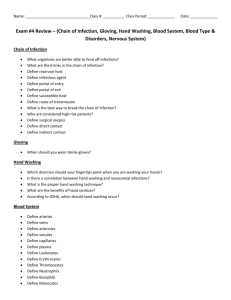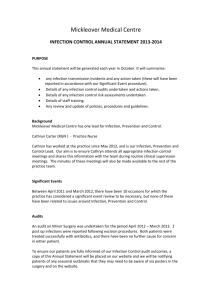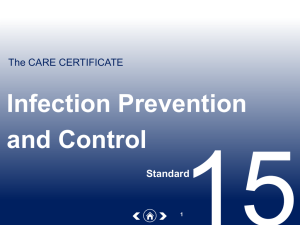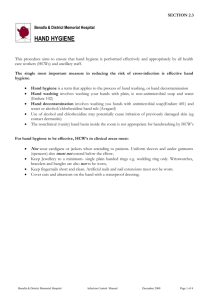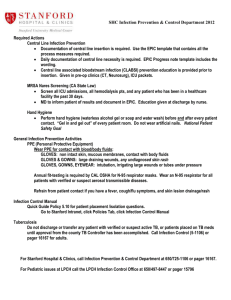Safe Work Procedure_ Routine infection control practices G
advertisement
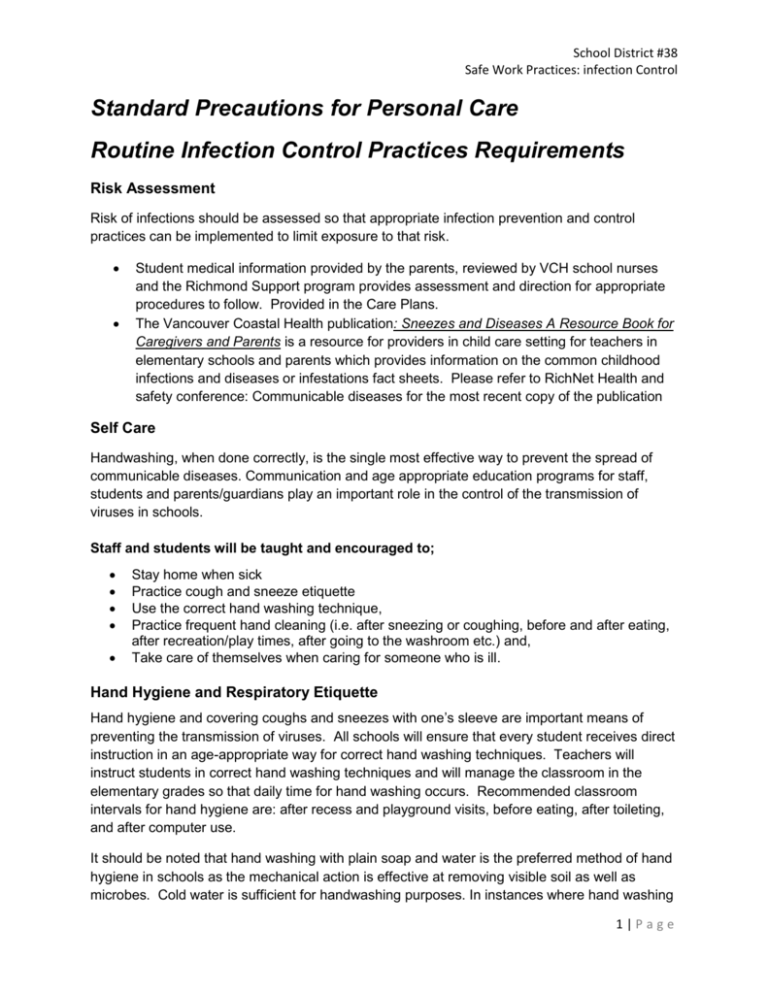
School District #38 Safe Work Practices: infection Control Standard Precautions for Personal Care Routine Infection Control Practices Requirements Risk Assessment Risk of infections should be assessed so that appropriate infection prevention and control practices can be implemented to limit exposure to that risk. Student medical information provided by the parents, reviewed by VCH school nurses and the Richmond Support program provides assessment and direction for appropriate procedures to follow. Provided in the Care Plans. The Vancouver Coastal Health publication: Sneezes and Diseases A Resource Book for Caregivers and Parents is a resource for providers in child care setting for teachers in elementary schools and parents which provides information on the common childhood infections and diseases or infestations fact sheets. Please refer to RichNet Health and safety conference: Communicable diseases for the most recent copy of the publication Self Care Handwashing, when done correctly, is the single most effective way to prevent the spread of communicable diseases. Communication and age appropriate education programs for staff, students and parents/guardians play an important role in the control of the transmission of viruses in schools. Staff and students will be taught and encouraged to; Stay home when sick Practice cough and sneeze etiquette Use the correct hand washing technique, Practice frequent hand cleaning (i.e. after sneezing or coughing, before and after eating, after recreation/play times, after going to the washroom etc.) and, Take care of themselves when caring for someone who is ill. Hand Hygiene and Respiratory Etiquette Hand hygiene and covering coughs and sneezes with one’s sleeve are important means of preventing the transmission of viruses. All schools will ensure that every student receives direct instruction in an age-appropriate way for correct hand washing techniques. Teachers will instruct students in correct hand washing techniques and will manage the classroom in the elementary grades so that daily time for hand washing occurs. Recommended classroom intervals for hand hygiene are: after recess and playground visits, before eating, after toileting, and after computer use. It should be noted that hand washing with plain soap and water is the preferred method of hand hygiene in schools as the mechanical action is effective at removing visible soil as well as microbes. Cold water is sufficient for handwashing purposes. In instances where hand washing 1|Page School District #38 Safe Work Practices: infection Control sinks are not available, use of alcohol based hand sanitizers may be considered. If hands are visibly soiled, alcohol based hand sanitizers may not be effective at eliminating the influenza virus. Information for distribution on hand hygiene and cough etiquette can be found at: http://www.fightflu.ca/ and at http://www.gov.bc.ca/h1n1/backtoschool/index.html. Posters have been sent to school sites to renew handwashing signage. Additional Age appropriate educational materials have been assembled and can be found on RichNet Health and Safety Conference and from the assigned School Nurse. Infection Control Practices: Routine infection control practices must be followed by all staff even when no there is no sign of infection. Routine infection control practices help reduce the chance of infection from spreading from one person to another. 1. Wash your hands: a. before and after direct student care b. Immediately after removing personal protective equipment e.g. gloves c. Before and after handling or preparing food d. After contact with blood or body fluids e. After contact with items likely to be contaminated with blood or body fluids f. Frequently during your shift. 2. Use personal protective equipment provided: a. Use disposable gloves when handling blood or body fluids, when cleaning cuts or scrapes or when changing a diaper b. Gowns and aprons should be worn to protect uncovered skin and prevent soiling of clothing during activities or procedures that are likely to generate splashes or spray of blood, body fluids, secretions And excretions c. Eye protections, face shields should be worn to protect mucous membranes of the eyes, nose and mouth during procedures and activities that are likely to generate splashes or spray of blood, body fluids, secretions and excretions. Choose eyewear that protects eye from all directions. d. N95 particulate respirator (a rated disposable dust mask) for communicable infections spread by airborne route requires fit testing to ensure a correct fit. 3. Clean and sanitize diaper changing areas between uses 4. Keep toilets and other surfaces visibly clean 5. Do not share personal items such as hair brushes, toothbrushes, towels, facecloths, or hats 6. Wash laundry using detergent and warm water. Soiled clothing can be put into a plastic bag. Tie the bag closed. Send the clothes home to be washed. 7. During disease outbreaks, follow the guidance of public health about additional steps to take control of the spread of disease 8. Separate sick children from well children 2|Page School District #38 Safe Work Practices: infection Control 9. Clean and sanitize all client care equipment instruments and devises according to required guidelines 10. Waste disposal – sharps to be disposed of in sharps container. 11. Environmental Cleaning a. Horizontal/high touch surfaces such as work counters, need to be cleaned daily and when visibly soiled. These surfaces may also require low level disinfection depending on the procedure being done. 3|Page


